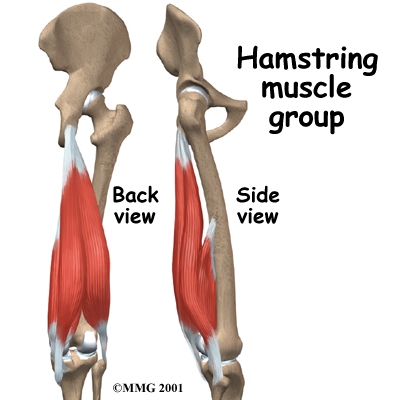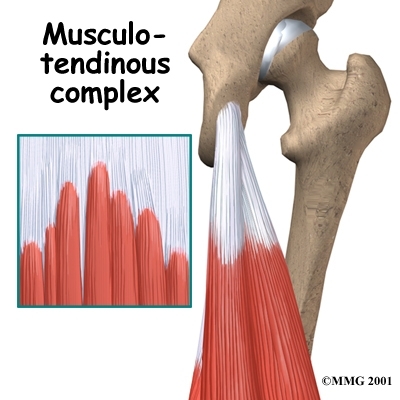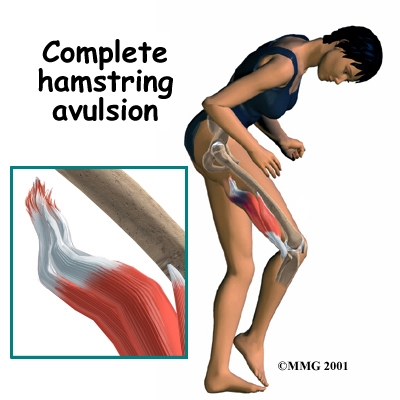A Patient's Guide to Hamstring Injuries

Introduction
The big group of muscles and tendons in the back of your thigh are commonly called the hamstrings. Injuries in this powerful muscle group are common, especially in athletes. Hamstring injuries happen to all types of athletes--from Olympic sprinters to slow-pitch softball players. Though these injuries can be very painful, they will usually heal on their own. But for an injured hamstring to return to full function, it needs special attention and a specially designed rehabilitation program.
This guide will help you understand
- how the hamstrings work
- why hamstring injuries cause problems
- how doctors treat the condition
Chiropractic Treatment
Chiropractors who treat a lot of athletes see may patients with hamstring injuries. For minor muscle pulls, you may need two to four weeks to safely get back to your activities. For more severe muscle tears, you may need chiropractic rehabilitation for two to three months, with complete healing occurring by four to six months.
It is very important to treat and rehabilitate your hamstring injury correctly. Incomplete or improper healing makes re-injury much more likely. For the first three to five days after the injury, the main goal of treatment is to control the swelling, pain, and hemorrhage (bleeding). Hamstring injuries are initially treated using the RICE method. RICE stands for rest, ice, compression, and elevation.
A good chiropractic doctor will examine the entire kinetic chain that is look at your feet, knees, hips, pelvis and lower back. Small muscle imbalances, poor posture, faulty running biomechanics, joint restrictions at the knee and hip can all contribute to hamstring injuries. If these are not corrected, the problem will keep returning.
Chiropractic adjustments/manipulations are performed to help restore normal biomechanics to these areas. This is where chiropractic manipulation has an advantage over other specialties. Research has shown that after a spinal manipulation is performed at to the low back, there is an increase of strength of the quadriceps and hamstrings. This is due to stimulation of the nerve supply to those muscles.
Custom made orthotics may also be prescribed for your shoes to help support the arches of your feet and correct poor biomechanics.
Rest
Rest is critical. Your chiropractic doctor may recommend a short period (up to one week) of immobilization. Severe tears may require a longer period of rest. This may mean you spend most of your time lying down. You may need to use crutches to get around. If you put too much weight on your hamstring after an injury, more damage may occur and more scar tissue may form.
Ice
Ice applied to the injured hamstring controls swelling and pain but doesn't stop it completely. This is important because your body's inflammatory response actually helps your muscles heal. Cold treatments slow the metabolism and blood flow in the area. Cold also reduces your sensations of pain by numbing the nerves. And experiencing less pain helps you relax, reducing muscle spasms.
A plastic bag full of ice cubes or crushed ice, held on with an elastic bandage, is the most effective type of cold treatment. The ice should be kept on the injury for twenty to thirty minutes. You can also use cold gel packs, chipped ice, or cold sprays. Cold treatments should be repeated at least four times a day for the first two to three days. They can be done as often as every two hours if needed.
Compression
Compression can help reduce the bleeding in your muscle to limit swelling and scarring. To apply compression, your doctor may suggest that you wrap your hamstring firmly in an elastic bandage. It is unclear exactly how effective compression is in hamstring injuries, but patients often report having less pain with the wrap.
Elevation
Elevation can help reduce swelling. It also keeps your leg immobilized. The key to elevation is to raise and support the injured body part above the level of the heart. In the case of a hamstring injury, this requires lying down and supporting the leg up on pillows.
As your hamstrings begin to heal, it is critical that you follow an exercise program to regain your strength and mobility. Specially designed exercises encourage your body to rebuild muscle instead of scar tissue. The exercises also help prevent re-injury. Rehabilitation can be slow, so you will need to be patient and not push yourself too hard or too fast.
Early in your chiropractic rehabilitation, exercises may be done in a swimming pool or on a stationary bike set to low resistance. These exercises allow you to take your hamstrings through a range of motion without having to hold up your weight. When you can walk without a limp and feel very little tenderness, you can start a walking program. Eventually you can work up to jogging.
Stretching will be a key feature of your rehabilitation program. You will be shown how to stretch. Plan to continue these stretches even after you heal, because a re injury of the same hamstring is common. Increasing your flexibility may help you avoid another hamstring injury in the future. It is important that you maintain good flexibility to keep your hamstrings healthy.
Strengthening exercises usually begin with isometric exercises. These exercises involve contracting the muscles without moving your leg joints. As your hamstrings get stronger, light weights are used. It is important that you feel no pain during these exercises.
You should maintain your general level of fitness throughout your rehabilitation. We can suggest workouts that don't stress your hamstrings.
Most hamstring injuries get better with treatment. Even world-class athletes with severe hamstring injuries are usually able to return to competition. By keeping the hamstrings flexible and giving the body time to heal, you should be able to return to the activities you enjoy.
Anatomy
Where are the hamstrings, and what do they do?
The hamstrings make up the bulk in back of the thigh. They are formed by three muscles and their tendons. The hamstrings connect to the ischial tuberosity, the small bony projection on the bottom of the pelvis, just below the buttocks. (There is one ischial tuberosity on the left and one on the right.) The hamstring muscles run down the back of the thigh. Their tendons cross the knee joint and connect on each side of the shinbone (tibia).
The hamstrings function by pulling the leg backward and by propelling the body forward while walking or running. This is called hip extension. The hamstrings also bend the knees, a motion called knee flexion.
Most hamstring injuries occur in the musculotendinous complex. This is the area where the muscles and tendons join. (Tendons are bands of tissue that connect muscles to bones.) The hamstring has a large musculotendinous complex, which partly explains why hamstring injuries are so common.

When the hamstring is injured, the fibers of the muscles or tendon are actually torn. The body responds to the damage by producing enzymes and other body chemicals at the site of the injury. These chemicals produce the symptoms of swelling and pain.
In a severe injury, the small blood vessels in the muscle can be torn as well. This results in bleeding into the muscle tissue. Until these small blood vessels can repair themselves, less blood can flow to the area. With this reduced blood flow, the muscles cannot begin to heal.
The chemicals that are produced and the blood clotting are your body's way of healing itself. Your body heals the muscle by rebuilding the muscle tissue and by forming scar tissue. Carefully stretching and exercising your injured muscle helps maximize the building of muscle tissue as you heal.
In rare cases, an injury can cause the muscle and tendons to tear away from the bone. This happens most often where the hamstring tendons attach to the ischial tuberosity. These tears, called avulsions, sometimes require surgery.
Causes
How do hamstring injuries occur?
Hamstring injuries happen when the muscles are stretched too far. Sprinting and other fast or twisting motions with the legs are the major cause of hamstring injuries. Hamstring injuries most often occur in running, jumping, and kicking sports. Water skiing, dancing, weight lifting, and ice-skating also cause frequent hamstring injuries. These sports are also more likely to cause avulsions.
The major factors in hamstring injuries are low levels of fitness and poor flexibility. Children very seldom suffer hamstring injuries, probably because they are so flexible. Muscle fatigue and not warming up properly can contribute to hamstring injuries.
Imbalances in the strength of different leg muscles can lead to hamstring injuries. The hamstring muscles of one leg may be much stronger than the other leg, or the quadriceps muscles on the front of the thigh may overpower the hamstrings.
Symptoms
What does a hamstring injury feel like?
Hamstring injuries usually occur during heavy exercise. In especially bad cases, an athlete may suddenly hear a pop and fall to the ground. The athlete may be able to walk with only mild pain even in a severe injury. But taking part in strenuous exercise will be impossible, and the pain will continue.
In less severe cases, athletes notice a tight feeling or a pulling in their hamstring that slows them down. This type of hamstring injury often turns into a long-lasting problem.
The hamstring may be pulled, partially torn, or completely torn. The injury can happen at the musculotendinous junction (mentioned earlier), within the muscle, or where the tendon connects on the ischial tuberosity (avulsion). In the rare case of a complete tear, the pain is excruciating. The torn tissues may form a hard bunch in the back of the thigh when the leg is bent. The skin may also bruise, turning purple from bleeding under the skin. This is not necessarily dangerous but can look somewhat alarming.

Diagnosis
How do doctors diagnose the condition?
Your doctor will take a detailed medical history that includes questions about your exercise schedule, your activities, and the way you warm up. You will also need to describe your symptoms.
Your doctor will examine the back of your thigh. The physical exam will involve flexing and extending your leg. The probing and the movement may hurt, but it is important to identify exactly where and when you feel pain.
Your doctor may want to schedule you for imaging tests. X-rays usually don't show hamstring injuries, but they may rule out other problems, such as an avulsion.
Magnetic resonance imaging (MRI) can be useful in showing the details of muscle injuries. An MRI scan is a special radiological test that uses magnetic waves to create pictures that look like slices of the hamstring. The MRI scan is painless and requires no needles or special dye.
Doctors group hamstring injuries into three categories. The following images show each grade of injury
Grade one injuries are muscle pulls that do not result in much damage to the structure of the tissues. Grade two injuries are partial tears. Grade three injuries are complete tears.
All content provided by eORTHOPOD® is a registered trademark of Medical Multimedia Group, L.L.C.. Content is the sole property of Medical Multimedia Group, L.L.C.. and used herein by permission.
All materials from eORTHOPOD® are the sole property of Medical Multimedia Group, L.L.C.. and are used herein by permission. eORTHOPOD® is a registered trademark of Medical Multimedia Group, L.L.C..
|